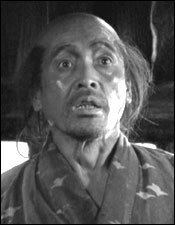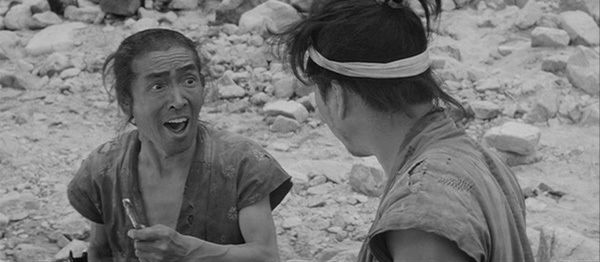Cause of death Heart attack Name Kamatari Fujiwara Years active 1933–1984 | Occupation Actor Other names Keita Fujiwara Role Actor | |
 | ||
Died December 21, 1985, Tokyo, Japan Movies The Hidden Fortress, Seven Samurai, Yojimbo, To Live, Sanjuro Similar People | ||
Kamatari Fujiwara (藤原 釜足 Fujiwara Kamatari, January 15, 1905 - December 21, 1985) was a Japanese actor.
Contents
- Initial work with Asakusa Opera Movement
- Marriage
- Casino Follies
- First films
- Marriage to Sadako Sawamura
- Work with Kurosawa
- Manzo
- Hidden Fortress and R2D2
- Later life and death
- Filmography
- References

Fujiwara was born in Tokyo, on January 15, 1905, in Tokyo, Japan. Fujiwara's parents ran a printing business. The business did not go well, so at the age of 10, Fujiwara started working at a local confectionery store. By the age of 14 he had started selling timber for building and manufacturing in Shizuoka prefecture. A year later he returned to Tokyo to study as a pharmacist.
Fukiwara worked regularly and extensively with Akira Kurosawa, and was known for both being adept at comic acting, as well as being able to do serious roles
Initial work with Asakusa Opera Movement
The Asakusa Opera Movement was started in 1916, and was part of the mass culture of the time. By the 1920s it had become very popular. Fujiwara, inspired by this, enrolled at the Takinogawa actor/martial arts school. After graduation, he approached actor Kuroki Kenzo to see if he would personally teach him acting. His first work was on stage as a chorist. Realising that he was short, not particularly attractive, and unlikely to have a main part on stage, he decided to diversify his skills for performance and started studying violin at Toyo music school.
Following the Great Kantō earthquake, the Asakusa Opera movement started losing popularity. As a result, Fujiwara worked at the movie theatre as a violinist, where his lesser height and unattractiveness were not an issue.
Marriage
Perhaps, in spite of his looks, Fujiwara married an unknown village woman. They had a son; however, after his birth she died.
Casino Follies
At this time, an old friend, actor and comedian Kenichi Enomoto, asked him to join the Casino Follies. The Casino Follies were a huge complex of theatres, music halls, and movie houses that drew large numbers of people to the Asakusa district, previously the heart of old Edo. As part of the troupe, he was able to use physical comedy, utilising Karate breakfalls and blows he had learnt in his stage tuition in the Akasuar. In the late 1920s this was the era of the Ero Guru, a Japanese equivalent of the American flapper phenomenon. In 1933 he resigned from Casino Follies and became a movie actor.
First films
His first movie was Ongaku Kigeki - Horoyui Jinsei (in English - Musical Comedy - Intoxicated life) made in 1933. It was a comedy about the joys of beer drinking. This was a Toho Film Company production and in fact most of his movies, for 40 years, were made with Toho.
Marriage to Sadako Sawamura
In 1936 he married popular fellow actor Sadako Sawamura, whom he had met whilst working together on set. Though they acted in many Toho Studio films, they were only in two together; Toyuki a Chinese/Japanese co production made in 1940 and Uma, made in 1941. They did not produce children and divorced in 1946. Fujiwara did not remarry again.
Work with Kurosawa
He made his first appearance in a Kurosawa film alongside Takashi Shimura in 1952's Ikiru. He played the role of Senkichi. Fujiwara's shomin persona is always that of a real-life person. Generally he played the role of an ordinary subject-citizen: petty, conservative, mediocre, far from being handsome or rich. Over time he made this his specialty. All up, Fujiwara appeared in 11 of Kurosawa' s films, and along with Mifune, Shimura, Nakadai and Chiaki, was regarded as one of Kurosawa's core actors . Perhaps the two most famous roles for Kurosawa were the well-remembered role in The Lower Depths, where he plays a drunken Kabuki actor complaining about his "Bitol Organs", and his role as Manzo in Seven Samurai. Ironically, despite his roles generally being supporting roles to other action type actors like Mifune, Fujiwara was an accomplished martial artist which he had gained and applied to his stage performance in his earlier years.
Manzo
Fujiwara's perhaps most famous role abroad was as the character of Manzo, in the famous Akira Kurosawa movie, Seven Samurai. The character of Manzo was a paranoid peasant, who protected his daughter from the attentions of the Samurai by dressing her as a little boy. The character's story is part of the key plot. Manzo, like many of the characters that Fujiwara portrayed, is low class, and disheveled.
Hidden Fortress and R2D2
One of his largest roles was in the Kurosawa epic, Hidden Fortress. It was in this role that he played a comic grotesque, opposite Mifune. His annoying peasant character Matashichi gave inspiration to George Lucas for R2D2. The taller fellow lead character, Tahei, played by Minoru Chiaki served as the inspiration for C-3PO. Additionally, the characters and general plotline involving a princess fleeing an evil empire formed the basis for Lucas's movie, Star Wars.
Despite the influence, Fujiwara received no money from Lucas, and Lucas never personally thanked Fujiwara. Fujiwara may or may not have seen the Star Wars films, but he did not comment on what he thought of R2D2 or any other of the characters.George Lucas acknowledged heavy influence of The Hidden Fortress on Star Wars, particularly the technique of telling the story from the perspective of the film's lowliest characters, C-3PO and R2-D2.
He became a long-time member of director Akira Kurosawa's company of actors until his death. Today he is remembered primarily for his supporting appearances in Kurosawa's films, particularly as the suspicious farmer Manzō (万造) in Seven Samurai, the deranged former mayor in Yojimbo, the spidery treasure-seeking farmer in The Hidden Fortress, and the drunken Kabuki actor in The Lower Depths. Apart from working with Kurosawa, he worked with the director Yasujirō Ozu in Tokyo Twilight, playing the role of Chin Chin Ken at the Ramen bar, and also voiced the role of daddy in the movie version of long running Anime, Sazae San.
He had difficulty remembering lines. When Arthur Penn, the American film director of Bonnie and Clyde, and Little Big Man, needed a Japanese actor for his film Mickey One, Penn was so impressed with the performance of Kamatari Fujiwara as the peasant who tries to disguise his daughter as a boy in Akira Kurosawa's 1954 Seven Samurai that he hired him to play the deaf-mute character simply known as "the artist" in his own film surrealist movie.
Fujiwara had a long running career, appearing in more than 70 films, and in addition to this more than 50 TV appearances, from the 1930s to 1984.
Later life and death
Fujiwara retired in the late 1970s, though he continued to make occasional television appearances. His final film role was a memorable cameo in Juzo Itami's The Funeral (お葬式, 1984). He died in 1985 at the age of 80 in a Tokyo hospital after suffering a heart attack. Osaka's Abuyama old Mound serves as his final burial site.
